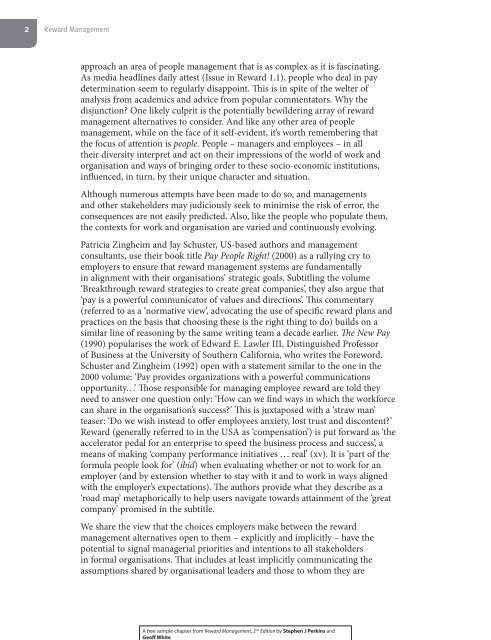Introducing the Reward Management System - CIPD
Introducing the Reward Management System - CIPD
Introducing the Reward Management System - CIPD
Create successful ePaper yourself
Turn your PDF publications into a flip-book with our unique Google optimized e-Paper software.
2<br />
<strong>Reward</strong> <strong>Management</strong><br />
approach an area of people management that is as complex as it is fascinating.<br />
As media headlines daily attest (Issue in <strong>Reward</strong> 1.1), people who deal in pay<br />
determination seem to regularly disappoint. This is in spite of <strong>the</strong> welter of<br />
analysis from academics and advice from popular commentators. Why <strong>the</strong><br />
disjunction? One likely culprit is <strong>the</strong> potentially bewildering array of reward<br />
management alternatives to consider. And like any o<strong>the</strong>r area of people<br />
management, while on <strong>the</strong> face of it self-evident, it’s worth remembering that<br />
<strong>the</strong> focus of attention is people. People – managers and employees – in all<br />
<strong>the</strong>ir diversity interpret and act on <strong>the</strong>ir impressions of <strong>the</strong> world of work and<br />
organisation and ways of bringing order to <strong>the</strong>se socio-economic institutions,<br />
influenced, in turn, by <strong>the</strong>ir unique character and situation.<br />
Although numerous attempts have been made to do so, and managements<br />
and o<strong>the</strong>r stakeholders may judiciously seek to minimise <strong>the</strong> risk of error, <strong>the</strong><br />
consequences are not easily predicted. Also, like <strong>the</strong> people who populate <strong>the</strong>m,<br />
<strong>the</strong> contexts for work and organisation are varied and continuously evolving.<br />
Patricia Zingheim and Jay Schuster, US-based authors and management<br />
consultants, use <strong>the</strong>ir book title Pay People Right! (2000) as a rallying cry to<br />
employers to ensure that reward management systems are fundamentally<br />
in alignment with <strong>the</strong>ir organisations’ strategic goals. Subtitling <strong>the</strong> volume<br />
‘Breakthrough reward strategies to create great companies’, <strong>the</strong>y also argue that<br />
‘pay is a powerful communicator of values and directions’. This commentary<br />
(referred to as a ‘normative view’, advocating <strong>the</strong> use of specific reward plans and<br />
practices on <strong>the</strong> basis that choosing <strong>the</strong>se is <strong>the</strong> right thing to do) builds on a<br />
similar line of reasoning by <strong>the</strong> same writing team a decade earlier. The New Pay<br />
(1990) popularises <strong>the</strong> work of Edward E. Lawler III, Distinguished Professor<br />
of Business at <strong>the</strong> University of Sou<strong>the</strong>rn California, who writes <strong>the</strong> Foreword.<br />
Schuster and Zingheim (1992) open with a statement similar to <strong>the</strong> one in <strong>the</strong><br />
2000 volume: ‘Pay provides organizations with a powerful communications<br />
opportunity. . .’ Those responsible for managing employee reward are told <strong>the</strong>y<br />
need to answer one question only: ‘How can we find ways in which <strong>the</strong> workforce<br />
can share in <strong>the</strong> organisation’s success?’ This is juxtaposed with a ‘straw man’<br />
teaser: ‘Do we wish instead to offer employees anxiety, lost trust and discontent?’<br />
<strong>Reward</strong> (generally referred to in <strong>the</strong> USA as ‘compensation’) is put forward as ‘<strong>the</strong><br />
accelerator pedal for an enterprise to speed <strong>the</strong> business process and success’, a<br />
means of making ‘company performance initiatives . . . real’ (xv). It is ‘part of <strong>the</strong><br />
formula people look for’ (ibid) when evaluating whe<strong>the</strong>r or not to work for an<br />
employer (and by extension whe<strong>the</strong>r to stay with it and to work in ways aligned<br />
with <strong>the</strong> employer’s expectations). The authors provide what <strong>the</strong>y describe as a<br />
‘road map’ metaphorically to help users navigate towards attainment of <strong>the</strong> ‘great<br />
company’ promised in <strong>the</strong> subtitle.<br />
We share <strong>the</strong> view that <strong>the</strong> choices employers make between <strong>the</strong> reward<br />
management alternatives open to <strong>the</strong>m – explicitly and implicitly – have <strong>the</strong><br />
potential to signal managerial priorities and intentions to all stakeholders<br />
in formal organisations. That includes at least implicitly communicating <strong>the</strong><br />
assumptions shared by organisational leaders and those to whom <strong>the</strong>y are<br />
A free sample chapter from <strong>Reward</strong> <strong>Management</strong>, 2 nd Edition by Stephen J Perkins and<br />
Geoff White<br />
Published by <strong>the</strong> <strong>CIPD</strong>.<br />
Copyright © <strong>CIPD</strong> 2011<br />
All rights reserved; no part of this excerpt may be reproduced, stored in a retrieval system,<br />
or transmitted in any form or by any means, electronic, mechanical, photocopying, recording,<br />
or o<strong>the</strong>rwise without <strong>the</strong> prior written permission of <strong>the</strong> Publishers or a licence permitting<br />
restricted copying in <strong>the</strong> United Kingdom issued by <strong>the</strong> Copyright Licensing Agency.<br />
If you would like to purchase this book please visit www.cipd.co.uk/bookstore.

















